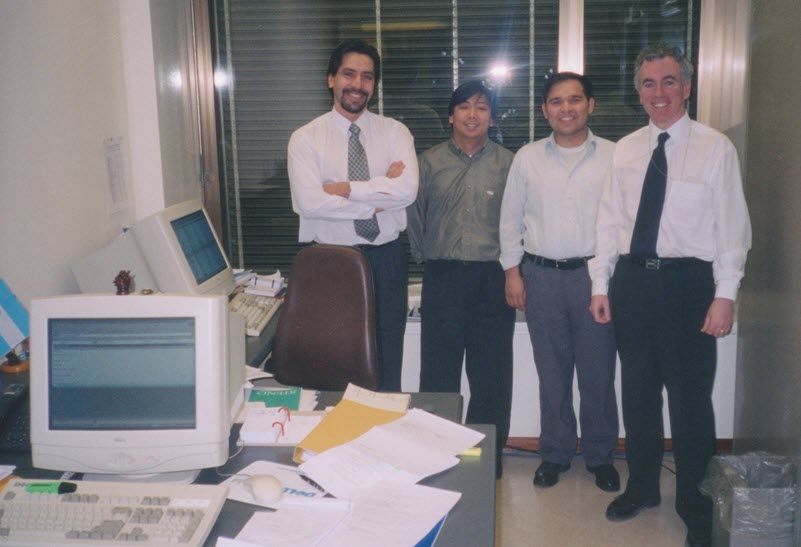Version française - Versión española
 After 35 years of service within the DMFAS Programme, including 18 years as Chief of the Programme , Gerry Teeling is retiring from UNCTAD.
After 35 years of service within the DMFAS Programme, including 18 years as Chief of the Programme , Gerry Teeling is retiring from UNCTAD.
DMFAS. Having worked with the DMFAS Programme for over 35 years, including 18 years as the Programme’s Chief, what evolutions did you witness in the Programme’s work and in debt management technical assistance ?
Gerry Teeling. The evolution of the Programme followed the evolution of countries’ needs. When I started in the late 80’s, the Programme was focusing on central government and government guaranteed external debt, and the main emphasis was on constituting reliable and complete external central government debt databases and basic reporting.
As the years went on, the Programme’s work adapted to the changing needs of the debt management offices (DMOs), both in terms of the scope of debt data countries were working with and the type of reporting functionality they needed. In terms of scope, for example, there was a major change in the type of instruments to be recorded and reported on, in particular on domestic debt.
In relation to reporting, as public debt management became more and more recognized as an integral part of public finance management and the focus on debt sustainability and transparency became stronger, the reporting needs became more extensive and increasingly complex.
Did you notice changes or evolution in the delivery of DMFAS technical assistance throughout the years?
Initially the technical assistance of the Programme focused on the delivery of the DMFAS software to countries and training them in its use. With countries’ increased reliance on debt data and more stakeholders needing to receive information on public debt, their needs evolved to include capacity building in areas such as data validation, debt statistics and debt portfolio analysis.
In terms of debt statistics the Programme got involved in the creation of international guidelines for public debt statistics as part of the Task Force on Finance Statistics led by the IMF and which resulted in the development of a new set of standards which DMFAS then integrated into its software and capacity-building. Subsequently, countries needed technical assistance from the Programme to become aware of those standards and to implement them.
In addition, the recognition of debt management as an integral part of public finance management also greatly changed DMFAS’ technical assistance to countries, as the Programme added support for integrating DMFAS with the other public finance management systems such as budget and accounting systems, including with Integrated Finance Management Information Systems (IFMIS) in many cases.
Over the years, the need and demand for technical assistance in public debt management have gradually become much stronger. When I started first with the Programme, only 4 or 5 countries were using the DMFAS system. Today almost 90 institutions in 61 countries use DMFAS and benefit from the Programme’s support.
With the forthcoming launch of DMFAS 7, what are your expectations for the future of the Programme?
I think that the Programme has been going from strength to strength and the prospects for the future are very strong. Based on the very high levels of satisfaction of its stakeholders, I am confident that DMFAS will continue to effectively provide essential support to developing countries in the critical area of public debt management. DMFAS 7 is going to enable countries to expand the scope of debt managed by DMOs to cover total public sector debt, including contingent liabilities. This will require a comprehensive system which covers the debt of non-central government entities such as sub nationals and SOEs, which is a new challenge for many countries. Moreover, countries need a system that provides powerful reporting tools and supports requirements for debt transparency. DMFAS 7 will bring these very much needed functionalities. What's notable is that this new version has been built in direct response to what countries have been telling us, and to the changing demands of public debt management.
I also expect that the DMFAS Advisory Group will continue to play an important role in the Programme’s future. For me, since its creation, the advisory group has proven to be an excellent forum to have exchanges not only between UNCTAD and user countries but also between the countries themselves. It was created to give Member States a direct voice in the governance of the Programme and in setting t priorities for DMFAS strategic planning, and it has served this purpose very well.It was a pleasure for me to have the opportunity to engage with all the countries during the advisory group meetings.
Any memory you would like to share?
On joining the DMFAS Programme in the mid-1980s as an IT expert, my first task was to rewrite the calculation of the amortization table in COBOL to improve the performance of the report generation in DMFAS 4. The system used to run over the whole weekend to generate batches of reports. But if there was a power cut or the servers stopped for any reason, the debt officers had to restart the entire reporting process which was extremely time-consuming, requiring them to go back to ledgers when they could not afford to wait. I remember the very positive surprise of the DMFAS users in one of the first countries in which we installed the new version when the reports were generated in 40 minutes – the head of the DMO saying that it was a miracle!
 Later, in the mid 1990’s, we did the first link between DMFAS and an Integrated Financial Management Information System (IFMIS); for me it was a great pleasure to see the achievement of straight-through processing of a payment order from DMFAS to the Central Bank; and then the payment confirmation coming directly from the Central Bank, back into DMFAS. That was a significant achievement that has since been replicated in so many countries With the integration, the quality of the data improved because it reduced the manual errors and increased the security of the payment orders. It also increased transparency and visibility, enabling monitoring of the whole process. I remember that it was amazing to walk through the DMO’s offices and watch all the staff using DMFAS as the main tool for their work – it reinforced for me that DMFAS was an essential tool for public debt management in the institution.
Later, in the mid 1990’s, we did the first link between DMFAS and an Integrated Financial Management Information System (IFMIS); for me it was a great pleasure to see the achievement of straight-through processing of a payment order from DMFAS to the Central Bank; and then the payment confirmation coming directly from the Central Bank, back into DMFAS. That was a significant achievement that has since been replicated in so many countries With the integration, the quality of the data improved because it reduced the manual errors and increased the security of the payment orders. It also increased transparency and visibility, enabling monitoring of the whole process. I remember that it was amazing to walk through the DMO’s offices and watch all the staff using DMFAS as the main tool for their work – it reinforced for me that DMFAS was an essential tool for public debt management in the institution.
A concluding word?
It has been an honour and a privilege for me to be part of this whole evolution in public debt management and to have contributed as part of the DMFAS Programme and in collaboration with so many stakeholders to the major advances made by countries in building their capacity for the effective management of their public liabilities.
The DMFAS community wishes you a happy and active retirement!